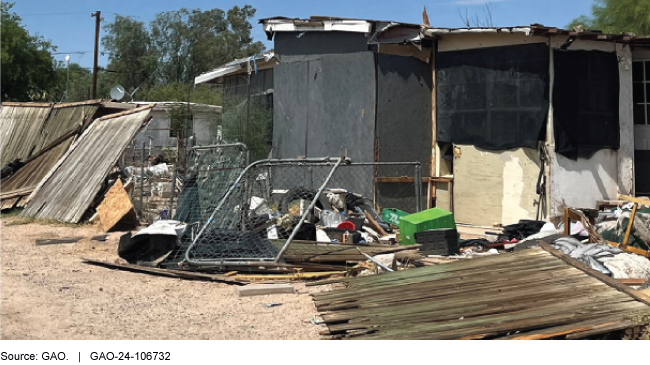Rural Development: Actions Needed to Improve Assistance to Southwest Border Communities Known as Colonias
Fast Facts
Colonias are predominantly rural, Hispanic communities near the U.S.-Mexico border. Many have poor access to drinking water, inadequate sewage systems, and substandard housing. Poverty rates are higher in regions with colonias.
HUD and USDA have 5 grant and loan programs that target colonias to improve water and wastewater systems and housing. But USDA doesn't have accurate data on the extent of its programs' benefits. And shifts in population may soon affect many colonias' eligibility for federal assistance.
We recommended Congress consider revising laws on colonia assistance eligibility and USDA better track its projects in colonias.
Conditions in and around a colonia in Pinal County, Arizona.

Highlights
What GAO Found
Colonias—predominately rural, Hispanic communities near the U.S.-Mexico border—face a range of economic, infrastructure, and environmental challenges. For example, regions with colonias have poverty rates 3 to 9 percentage points higher than other border regions. Further, housing values in areas with colonias are generally lower than those in the other border regions of each state, while the vacancy rates are generally higher.
Five Department of Housing and Urban Development (HUD) and U.S. Department of Agriculture (USDA) programs provide grants and loans targeted specifically to colonias to improve water and wastewater systems and housing. However, USDA's Single Family Housing programs do not have a process for identifying applications for projects in colonias. As a result, the agency does not have reliable data on the extent to which its programs are benefiting colonias, and aligning with agency and statutory goals for supporting these communities.
Many colonias face challenges in obtaining and using federal assistance. For example, local governments may not have the staff capacity to apply for some federally funded programs. In addition, the rural nature of these communities often makes it expensive to connect to existing infrastructure. To help address these challenges, HUD and USDA offer technical assistance and grants.
Due to population changes, nearly 60 percent of colonias will likely become ineligible in the future for certain targeted financial assistance. By statute, U.S.-Mexico border states must set aside a percentage of their HUD Community Development Block Grant (CDBG) funding for colonias located within metropolitan statistical areas of 1 million persons or less. However, many colonias are now part of areas that likely will soon exceed this threshold. This would render them ineligible for the set-aside, even though many of these areas continue to have rural characteristics. Revising the population requirement could help preserve eligibility for many communities that were originally intended to benefit from the set-aside.
A Colonia No Longer Eligible for Department of Housing and Urban Development Funding Remains Rural and Faces Poor Housing Conditions

Why GAO Did This Study
Colonias generally refer to rural communities in the border regions of Arizona, California, New Mexico, and Texas that are characterized by substandard housing and lack of access to adequate water and wastewater infrastructure. The Joint Explanatory Statement accompanying the Consolidated Appropriations Act, 2023 includes a provision for GAO to review the conditions of colonias and issues related to federal assistance available to them.
This report examines conditions in colonias, the federal assistance available to them, and challenges they may face in obtaining and using federal assistance. GAO analyzed American Community Survey data and reviewed USDA and HUD program documentation and funding data for fiscal years 2020–2023. GAO also interviewed representatives of federal agencies, state governments, and interest groups. GAO made physical observations and conducted interviews with local officials during site visits to 24 colonias in the four U.S.-Mexico border states.
Recommendations
Congress should consider revising the population requirement for colonias to receive CDBG set-aside funding given population growth in the Southwest. GAO is also making two recommendations to USDA, including that it develop procedures to identify applications for Single Family Housing assistance for projects in colonias. USDA agreed with both recommendations.
Matter for Congressional Consideration
| Matter | Status | Comments |
|---|---|---|
| Given population growth in the Southwest, Congress should consider revising the statutory requirement that, in order to be a colonia eligible for the CDBG set-aside, an identifiable community be located within an MSA with a population of 1 million or less. (Matter for Consideration 1) | As of February 2025, Congress had not acted on this matter for consideration. |
Recommendations for Executive Action
| Agency Affected | Recommendation | Status |
|---|---|---|
| Department of Agriculture | The Secretary of Agriculture should ensure that the Rural Housing Service Administrator develops and implements procedures for identifying and recording whether applications for Single Family Housing programs are for properties in colonias. (Recommendation 1) |
In January 2025, USDA said it will review the related procedures and make any necessary updates no later than Fiscal Year 2026 to better direct staff on identifying and properly coding applications for properties located in Colonias. National Office staff will work closely with State Office staff located within Colonias states to develop and provide training on any updates to ensure successful implementation. This recommendation will remain open until USDA has established and documented procedures and provided training that direct USDA staff on how to properly identify and record applications for properties located in colonias.
|
| Department of Agriculture | The Secretary of Agriculture should ensure that the Rural Housing Service Administrator uses data to track the extent to which Single Family Housing programs serve colonias and to inform its management of the programs. (Recommendation 2) |
In January 2025, USDA said that its Rural Housing Service staff will work with the USDA Rural Development Innovation Center to create enhanced reporting tools to better track program activities in Colonias. The reporting tools will be included in the training noted in the USDA's response to recommendation 1. This recommendation will remain open until USDA can demonstrate enhanced reporting tools to track the extent to which Single Family Housing programs serve colonias and to inform management of those programs.
|
